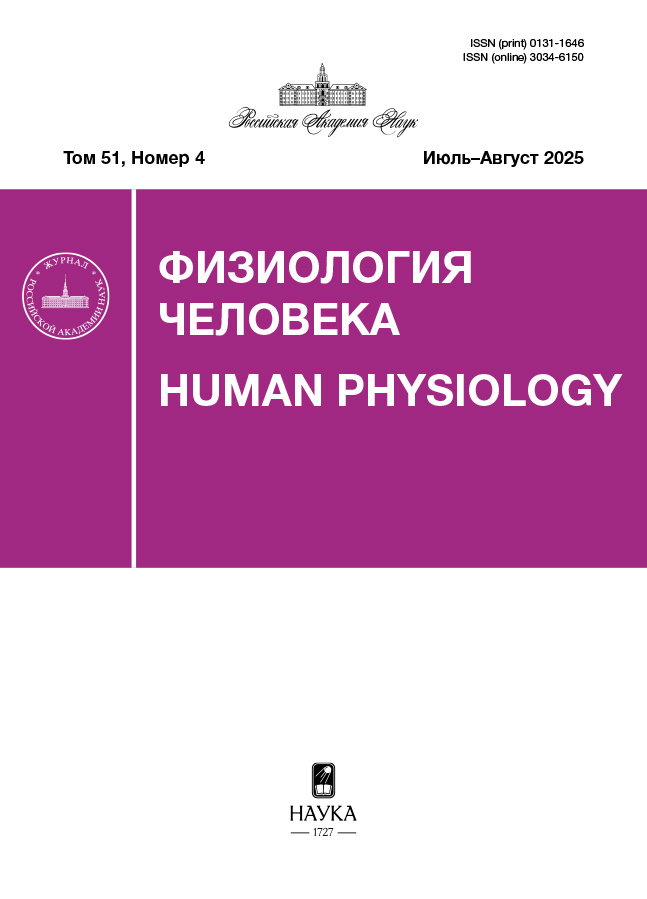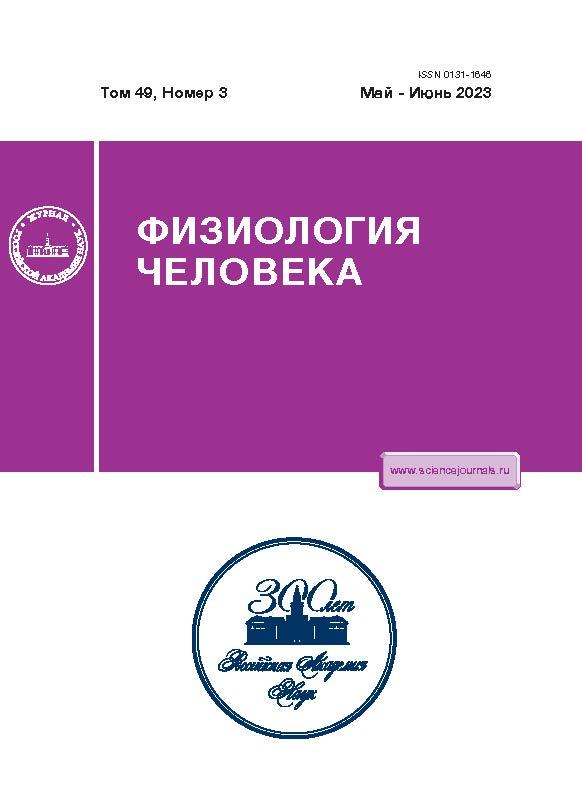Связанные с событиями потенциалы мозга человека при сравнении зрительных стимулов
- Авторы: Никишена И.С.1, Пономарев В.А.1, Кропотов Ю.Д.1
-
Учреждения:
- ФГБУН Институт мозга человека имени Н.П. Бехтеревой РАН
- Выпуск: Том 49, № 3 (2023)
- Страницы: 67-77
- Раздел: Статьи
- URL: https://cardiosomatics.ru/0131-1646/article/view/664011
- DOI: https://doi.org/10.31857/S0131164622600902
- EDN: https://elibrary.ru/GHALKW
- ID: 664011
Цитировать
Полный текст
Аннотация
Целью данного исследования было изучение особенностей работы мозга при сравнении зрительных стимулов в условиях отсроченной двигательной реакции. Исследовались потенциалы, связанные с событиями (ПСС), у 84 здоровых испытуемых в трехстимульном тесте, первые два стимула представляли собой пару сравнения, третий стимул запускал ответную двигательную реакцию. После предъявления второго стимула регистририровался комплекс из двух волн с затылочной (Oz, наиболее выраженный в интервале 100–150 мс) и задневисочной локализацией (P7, P8, 190–270 мс); отрицательное колебание в лобных отделах (Fz, 240–300 мс) и положительное колебание в теменных отделах (Pz, 270–450 мс). Ответы мозга различались по амплитуде в случае совпадения и несовпадения зрительных стимулов. В статье обсуждается физиологическое значение указанных волн и их различий в двух условиях.
Ключевые слова
Об авторах
И. С. Никишена
ФГБУН Институт мозга человека имени Н.П. Бехтеревой РАН
Автор, ответственный за переписку.
Email: nikishena@mail.ru
Россия, Санкт-Петербург
В. А. Пономарев
ФГБУН Институт мозга человека имени Н.П. Бехтеревой РАН
Email: nikishena@mail.ru
Россия, Санкт-Петербург
Ю. Д. Кропотов
ФГБУН Институт мозга человека имени Н.П. Бехтеревой РАН
Email: nikishena@mail.ru
Россия, Санкт-Петербург
Список литературы
- Bridger E.K., Kursawe A.L., Bader R. et al. Age effects on associative memory for novel picture pairings // Brain Res. 2017. V. 1664. P. 102.
- Spironelli C., Romeo Z., Maffei A., Angrilli A. Comparison of automatic visual attention in schizophrenia, bipolar disorder, and major depression: Evidence from P1 event-related component // Psychiatry Clin. Neurosci. 2019. V. 73. № 6. P. 331.
- Forschack N., Gundlach C., Hillyard S., Müller M.M. Electrophysiological evidence for target facilitation without distractor suppression in two-stimulus search displays // Cereb. Cortex. 2022. V. 32. № 17. P. 3816.
- Kappenman E.S., Farrens J.L., Zhang W. et al. ERP CORE: An open resource for human event-related potential research // Neuroimage. 2021. V. 225. P. 117465.
- Stahl J., Wiese H., Schweinberger S.R. Learning task affects ERP-correlates of the own-race bias, but not recognition memory performance // Neuropsychologia. 2010. V. 48. № 7. V. 10. P. 2027.
- He J., Zheng Y., Fan L. et al. Automatic Processing Advantage of Cartoon Face in Internet Gaming Disorder: Evidence From P100, N170, P200, and MMN // Front. Psychiatry. 2019. V. 10. P. 824.
- Male A.G., O’Shea R.P., Schröger E. et al. The quest for the genuine visual mismatch negativity (vMMN): Event-related potential indications of deviance detection for low-level visual features // Psychophysiology. 2020. V. 57. № 6. P. e13576.
- Kropotov J., Ponomarev V., Tereshchenko E.P. et al. Effect of Aging on ERP Components of Cognitive Control // Front. Aging Neurosci. 2016. V. 8. P. 69.
- Кропотов Ю.Д., Пономарев В.А., Пронина М.В., Полякова Н.В. Эффекты повторения и рассогласования стимулов в сенсорных зрительных компонентах потенциалов, связанных с событиями // Физиология человека. 2019. Т. 45. № 4. С. 5. Kropotov Y.D., Ponomarev V.A., Pronina M.V., Polyakova N.V. Effects of repetition and stimulus mismatch in sensory visual components of event-related potentials // Human Physiology. 2019. V. 45. № 4. P. 349.
- Wang P., Tan C.H., Li Y. et al. Event-related potential N270 as an index of social information conflict in explicit processing // Int. J. Psychophysiol. 2018. V. 123. P. 199.
- Rivera B., Soylu F. Incongruity in fraction verification elicits N270 and P300 ERP effects // Neuropsychologia. 2021. V. 161. P. 108015.
- Kropotov J.D., Ponomarev V.A. Differentiation of neuronal operations in latent components of event-related potentials in delayed match-to-sample tasks // Psychophysiology. 2015. V. 52. № 6. P. 826.
- Gemba H., Sasaki K. Potential related to no-go reaction of go/no-go hand movement task with color discrimination in human // Neurosci. Lett. 1989. V. 101. № 3. P. 263.
- Jodo E., Kayama Y. Relation of a negative ERP component to response inhibition in a Go/No-go task // Electroencephalogr. Clin. Neurophysiol. 1992. V. 82. № 6. P. 47715.
- Finkenzeller T., Doppelmayr M., Würth S., Amesberger G. Impact of maximal physical exertion on interference control and electrocortical activity in well-trained persons // Eur. J. Appl. Physiol. 2018. V. 118. № 12. P. 2509.
- Feldman J.L., Freitas A.L. An Analysis of N2 Event-Related Potential Correlates of Sequential and Response-Facilitation Effects in Cognitive Control // J. Psychophysiol. 2018. V. 33. № 2. P. 85.
- Zabelina D.L., Ganis G. Creativity and cognitive control: Behavioral and ERP evidence that divergent thinking, but not real-life creative achievement, relates to better cognitive control // Neuropsychologia. 2018. V. 118(Pt. A). P. 20.
- Xiao Y., Wu J., Tang W. et al. Cognition Impairment Prior to Errors of Working Memory Based on Event-Related Potential // Front. Behav. Neurosci. 2019. V. 13. P. 13.
- Overbye K., Walhovd K.B., Fjell A.M. et al. Electrophysiological and behavioral indices of cognitive conflict processing across adolescence // Dev. Cogn. Neurosci. 2021. V. 48. P. 100929.
- Polich J. Updating P300: an integrative theory of P3a and P3b // Clin. Neurophysiol. 2007. V. 118. № 10. P. 2128.
- Hillman C.H., Weiss E.P., Hagberg J.M., Hatfield B.D. The relationship of age and cardiovascular fitness to cognitive and motor processes // Psychophysiology. 2002. V. 39. № 3. P. 303.
- Vigário R.N. Extraction of ocular artifacts from EEG using independent component analysis // Electroencephalogr Clin. Neurophysiol. 1997. V. 103. № 3. P. 395.
- Dong L., Li F., Liu Q. et al. MATLAB Toolboxes for Reference Electrode Standardization Technique (REST) of Scalp EEG // Front. Neurosci. 2017. V. 11. P. 601.
- Hu S., Lai Y., Valdes-Sosa P.A. et al. How do reference montage and electrodes setup affect the measured scalp EEG potentials? // J. Neural Eng. 2018. V. 15. № 2. P. 026013.
- Perrin F., Pernier J., Bertrand O., Echallier J.F. Spherical splines for scalp potential and current density mapping // Electroencephalogr. Clin. Neurophysiol. 1989. V. 72. № 2. P. 184.
- Kayser J., Tenke C.E. Principal components analysis of Laplacian waveforms as a generic method for identifying ERP generator patterns: I. Evaluation with auditory oddball tasks // Clin. Neurophysiol. 2006. V. 117. № 2. P. 348.
- Kayser J., Tenke C.E. Principal components analysis of Laplacian waveforms as a generic method for identifying ERP generator patterns: II. Adequacy of low–density estimates // Clin. Neurophysiol. 2006. V. 117. № 2. P. 369.
- Maris E., Oostenveld R. Nonparametric statistical testing of EEG- and MEG-data // J. Neurosci. Methods. 2007. V. 164. № 1. P. 177.
- Pernet C.R., Latinus M., Nichols T.E., Rousselet G.A. Cluster-based computational methods for mass univariate analyses of event-related brain potentials/fields: A simulation study // J. Neurosci. Methods. 2015. V. 250. P. 85.
- Никишена И.С., Пономарев В.А., Кропотов Ю.Д. Потенциалы связанные с событиями в тесте на сравнение пар слов в зрительной и слуховой модальности // Физиология человека. 2021. Т. 47. № 4. С. 115. Nikishena I.S., Ponomarev V.A., Kropotov Y.D. E event-related potentials in audio-visual cross-modal test in comparison of word pairs // Human Physiology. 2021. V. 47. № 4. P. 459.
- Ahmadi M., McDevitt E.A., Silver M.A., Mednick S.C. Perceptual learning induces changes in early and late visual evoked potentials // Vision Res. 2018. V. 152. P. 101.
- Balla V.R., Szalóki S., Kilencz T. et al. A novel experimental paradigm with improved ecological validity reveals robust action-associated enhancement of the N1 visual event-related potential in healthy adults // Behav. Brain Res. 2020. V. 379. P. 112353.
- Woldorff M.G., Liotti M., Seabolt M. et al. The temporal dynamics of the effects in occipital cortex of visual-spatial selective attention // Brain Res. Cogn. Brain Res. 2002. V. 15. № 1. P. 1.
- Tartaglia E.M., Mongillo G., Brunel N. On the relationship between persistent delay activity, repetition enhancement and priming // Front. Psychol. 2015. V. 5. P. 1590.
- de Gardelle V., Waszczuk M., Egner T., Summerfield C. Concurrent repetition enhancement and suppression responses in extrastriate visual cortex // Cereb. Cortex. 2013. V. 23. № 9. P. 2235.
- Zhang X., Wang Y., Li Sh., Wang L. Event-related potential N270, a negative component to identification of conflicting information following memory retrieval // Clin. Neurophysiol. 2003. V. 114. № 12. P. 2461.
- Folstein J.R., Van Petten C. Influence of cognitive control and mismatch on the n2 component of the ERP: a review? // Psychophysiology. 2008. V. 45. № 1. P. 152.
- Scannella S., Pariente J., De Boissezon X. et al. N270 sensitivity to conflict strength and working memory: A combined ERP and sLORETA study // Behav. Brain Res. 2016. V. 297. P. 231.
- Verleger R., Grauhan N., Śmigasiewicz K. Is P3 a strategic or a tactical component? Relationships of P3 sub-components to response times in oddball tasks with go, no-go and choice responses // Neuroimage. 2016. V. 143. P. 223.
- Astle D.E., Jackson G.M., Swainson R. Dissociating neural indices of dynamic cognitive control in advance task–set preparation: an ERP study of task switching // Brain Res. 2006. V. 1125. № 1. P. 94.
- Elke S., Wiebe S.A. Proactive control in early and middle childhood: An ERP study // Dev. Cogn. Neurosci. 2017. V. 26. P. 28.
Дополнительные файлы















